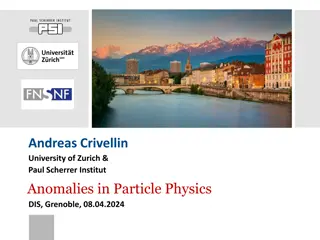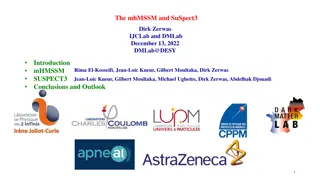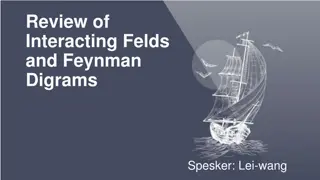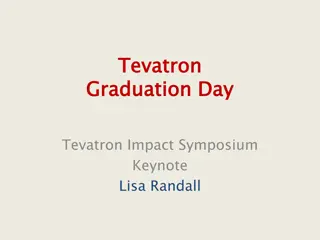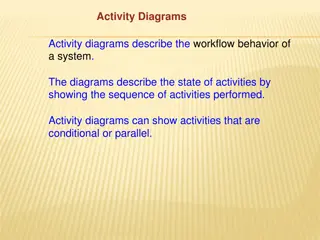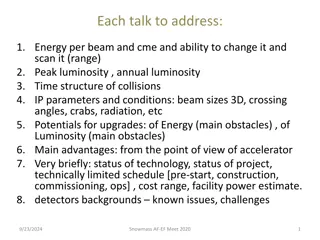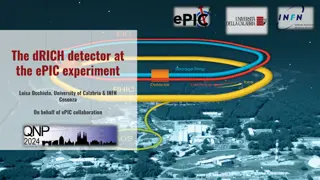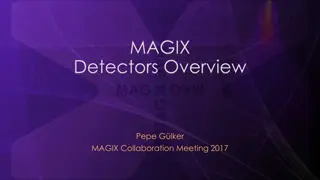Understanding Feynman Diagrams in Particle Physics
Feynman diagrams, developed by Richard Feynman in the 1940s, are a graphical technique to represent particle interactions in space-time. These diagrams use lines to depict particles, with fermions moving forward in time and antifermions moving backward. Vertices in the diagrams represent points where particles meet, conserving momentum, angular momentum, and charge. Each Feynman diagram corresponds to an amplitude in perturbation theory, aiding in calculations for various particle interactions and decays.
Download Presentation

Please find below an Image/Link to download the presentation.
The content on the website is provided AS IS for your information and personal use only. It may not be sold, licensed, or shared on other websites without obtaining consent from the author. Download presentation by click this link. If you encounter any issues during the download, it is possible that the publisher has removed the file from their server.
E N D
Presentation Transcript
Feynman diagrams In 1940s, R. Feynman developed a diagram technique to describe particle interactions in space-time. Feynman diagram example Richard Feynman time Particles are represented by lines Fermion ? Particles go forward in time Antifermion ? Antiparticles go backwards in time ?,?,? Gluon Boson Hans-J rgen Wollersheim - 2020
Feynman diagrams In 1940s, R. Feynman developed a diagram technique to describe particle interactions in space-time. Feynman diagram example Richard Feynman time Main assumptions and requirements: Time runs from left to right (convention) Particles are usually denoted with solid lines, and gauge bosons - with helices or dashed lines Arrow directed towards the right indicates a particle, otherwise antiparticle Points at which 3 or more particles meet are called vertices At any vertex, momentum, angular momentum and charge are conserved (but not energy) Hans-J rgen Wollersheim - 2020
Feynman diagrams Feynman diagrams are like circuit diagrams they show what is connected to, but length and angle of momentum vectors are not relevant. A particle moving (instantaneously) from one point to another space Richard Feynman A particle moving forward in time and space A particle at rest time Fermion ? Antifermion ? ?,?,? Gluon Boson Hans-J rgen Wollersheim - 2020
Vertices Lines connect into vertices, which are the building blocks of Feynman diagrams Charge, lepton number and baryon number as well as momentum are always conserved at a vertex. Compton scattering A photon scatters from an electron producing a photon and an electron in the final state Lowest order diagram has two vertices Hans-J rgen Wollersheim - 2020
Feynman Diagrams Each Feynman diagram represents an Amplitude (M) In lowest order perturbation theory M is the Fourier transformation of the potential. Born Approximation ?????????? ???? =2? Fermi s Golden Rule: ?2 ? ??? ????? Differential cross section for two body scattering (e.g. ?? ??) in the CM system: 2 qf= final state momentum vf= speed of final state particle vi= speed of initial state particle ?? ???? ?? ? = 1 ?2 4?2 The decay rate ( ) for a two body decay (e.g. ?0 ?+? ) in the CM system: m = mass of parent p = momentum of decay particle S = statistical factor (fermions/bosons) ? ? 8? ?2??2 = In most cases ??cannot be calculated exactly. Often M is expanded in a power series. Feynman diagrams represent terms in the series expansion of M. Hans-J rgen Wollersheim - 2020
Feynman Diagrams ???? ?1+ ?2 ?? = ? ?3,?3 ????? ?4,?4 ? ?2,?2 ????? ?1,?1 2 ? ??? ???? ?2 for massive particle: ?2 ?2 Hans-J rgen Wollersheim - 2020
Feynman Diagrams A coupling constant (multiplication factor) is associated with each vertex. Value of coupling constant depends on type of interaction ??= ??????? ? ???? (in units of electron charge) ? ? ?2 4? ? ?? ? = ?? Electromagnetic ? ?? Example: Compton scattering of an electron = 1137 ??????? ????????2 ? ? ? 1 2 1 2 ? ???????2 ?2 ?4 Total four-momenta conserved at a vertex Can move particle from initial to final state by replacing it into its antiparticle ? ?? ??????? ? ? ? Hans-J rgen Wollersheim - 2020
Real processes For a real process there must be energy conversation it has to be a combination of virtual processes ? 1 2 ? 1 2 ? 1 2 ? 1 2 Electron-electron scattering, single photon exchange Any real process receives contributions from all possible virtual processes ? ? 1 2 1 2 ? ? 1 2 1 2 Two-photon exchange contribution Hans-J rgen Wollersheim - 2020
Real processes ? ? 1 2 1 2 ? ? 1 2 1 2 Two-photon exchange contribution Number of vertices in a diagram is called its order Each vertex has an associated probability proportional to a coupling constant, usually denoted as . In the electromagnetic processes this constant is ?2 4??0 1 ???= 137 For the real processes, a diagram of the order n gives a contribution of order ?? Provided that is small enough, higher order contributions to many real processes can be neglected. Hans-J rgen Wollersheim - 2020
Real processes From the order of diagrams one can estimate the ratio of appearance rates of processes: ? ???? ?+? ??? ???? ?+? ?? = ? ? This ratio can be measured experimentally; it appears to be R = 0.9 10-3, which is smaller than em= 7 10-3, but the equation above is only a first order prediction. Diagrams are not related by time ordering For nucleus, the coupling is proportional to Z2 , hence the rate of this process is of the order of Z2 3. Hans-J rgen Wollersheim - 2020
Exchange of a massive boson Exchange of a massive particle X In the rest frame of particle A: ? ?0,?0 ? ??, ? + ? ??, ? where ?0= ??, ?0= 0,0,0 ?2+ ??2, ?2+ ??2 ??= ??= From this one can estimate the maximum distance over which X can propagate before being absorbed: ? = ??+ ?? ?? ?? This energy violation can exist only for ? ?, the interaction range is ? ? ?/?? Hans-J rgen Wollersheim - 2020
Exchange of a massive boson For a massless exchanged particle, the interaction has an infinite range (e.g. electromagnetic) In case of a very heavy exchanged particle (e.g. a W boson in weak interaction), the interaction can be approximated by a zero-range, or point interaction Point interaction as a result of MX ??? ?2=197.3 10 18 2 10 18? ??= ? ??= ? 80.4 80.4 Considering particle X as an electrostatic potential V(r), the Klein-Gordon equation for it will look like 1 ?2 ? ?? ?2?? 2 ? ? ?2? ? = = ?? ?? Hans-J rgen Wollersheim - 2020
Yukawa potential (1935) For nuclear forces with a range ?~10 15?, Yukawa hypothesis predicted a spinless quantum of mass: ??2= ? ? 100 ??? ??? ?2, ???? = 0 and strong nuclear The pion observed in 1947 had ? = 140 interactions. Nowadays: pion exchange still accounted for the longer-range part of nuclear potential. However, full details of interaction are more complicated. Hans-J rgen Wollersheim - 2020
Electroweak Interactions --Decay Beta decay: ? ? + ? + ?? Mediated by charged W exchange: The charge that goes into the vertex must equal the charge that comes out of it. Hans-J rgen Wollersheim - 2020
Electromagnetism At particle physics level the interaction is with the quarks Photons mediate the force between protons and electrons Hans-J rgen Wollersheim - 2020
Strong Interaction Gluons hold protons and neutron together and are responsible for the Strong force between them Hans-J rgen Wollersheim - 2020
Use of Feynman Diagrams Although they are used pictorially to show what is going on, Feynman Diagrams are used more seriously to calculate cross sections or decay rates. Draw all possible Feynman Diagrams for the process: 1 Propagator ~ ?2+?2 Assign values to each part of the diagram: free particle Vertex ~ charge Calculate the amplitude by multiplying together. Add the amplitudes for each diagram (including interference). Square the amplitude to get the intensity/probability (cross section or decay rate). Hans-J rgen Wollersheim - 2020



